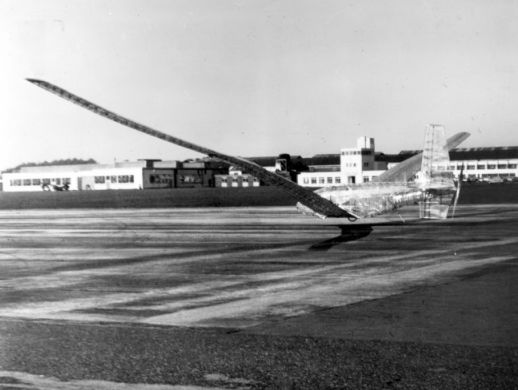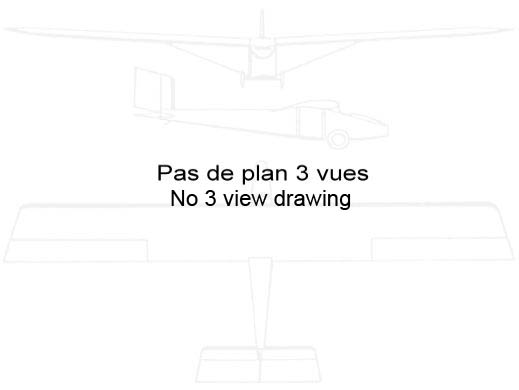
Weybridge Dumbo-Mercury
| DONNÉES GÉNÉRALES |
| Année du premier vol (ou de design, si seul projet) |
1971 |
| Pays | Angleterre |
| Designer(s) | GREEN, Phil & al. |
| Premier constructeur | |
| Type d'appareil | Propulsion musculaire |
| Fonction | Expérimental |
| SPÉCIFICATIONS TECHNIQUES |
| Envergure | 37.5 m |
| Longueur | -- |
| Hauteur | -- |
| Allongement | -- |
| Surface alaire | 47 m2 |
| Profil aile | Wortmann |
| Masse à vide | 80.7 kg |
| Masse maxi | -- |
| Charge alaire | -- |
| Vitesse mini | -- |
| Vitesse maxi | -- |
| Finesse maxi | |
| Taux de chute mini | -- |
| Nb sièges | 1 |
| Structure | Tubes d'aluminum. |
AUTRES INFORMATIONS
| Constructeur(s) |
| ||||||
| Infos techniques | Contrôle par déformation des ailes. | ||||||
| Histoire résumée | Premier vol le 18 septembre 1971. Construit en 3 ans par le Weybridge MPA Group, constitué majoritairement d’employés de British Aircraft Corp., installée à Weybridge. Masse 125 lb. Décolle de 3 ft le 18 septembre 1971, pour un vol de 50 pieds. A l’arrêt, les ailes très souples retombent, mais elles se redressent au cours du vol, avec un dièdre très prononcé. Czerwinski developed a new method of strong lightweight construction for HPA (Czerwinski 1967). This uses a framework of aluminium tubes. The joints are made by lashing with glassfibre. This principle was used by the Dumbo/Mercury, and was a precursor to the use of lashed tubes of more modern materials, eg carbon, Kevlar. A two-seater aircraft with two propellers was designed using this constructional system. The author knows of no record of flight trials. P.K. Green, W.F.Ball and M.J.Rudd were employed at BAC Weybridge, UK. This airfield is of interest, having been built on the famous Brooklands race-track, and was the home of the Vickers-Armstrong Aircraft Company, now part of British Aerospace. It is south of London, not far from Farnborough. The project started early in 1966. The aim of the designers was to increase wingspan without increasing weight. They considered that much of the weight on a wing is there only as structure to resist the loads, particularly torsional loads which occur when ailerons are used. They estimated that by eliminating ailerons, a 120 ft (36.6) m) wing could be built for the same weight as the 80 ft (24.4 m) wings of SUMPAC or Puffin. For lateral control the whole wing twisted from the root. In 1967 they learnt of the Czerwinski method of joining light alloy tubes as developed by the Ottawa group (JRAeS Jan 1967) and decided on this method of construction. Test-pieces of wing-spar (but without the enveloping secondary structure), the proposed transmission system and the innovatory wing-hinges were tested with practical help from the company. These hinges were not the simple affairs of the Mufli because this was a fully cantilevered wing. A recumbent pilot position was chosen, and a tail mounted propeller. With a shaft to the propeller, the rear part of the plane was like a neater version of the Puffin, having all moving surfaces. Construction started in mid 1968. As for Puffin 1, the wing spar was built curved so that it would straighten out in flight. The spar and the fuselage frame were girder-principle, built up from light alloy tubes etch-milled down to a thickness of 0.010 inch (1/4mm). The etch-milling was done by the company. Etch-milling involves chemicals of a strength which take it out of the realm of "kitchen-table" processes. However, using suitable precautions, later groups devised their own equipment. (See Gossamer Condor & Monarch). The parts for the secondary structure were made in member's homes. Each elaborate built-up-Balsa-strip fuselage frame was quite a piece of work in itself, but the individual ideas of each member are apparent in these, as in the wing ribs. It appeared to the author when he viewed the machine that not as much loving-care had gone into the nose-skinning as had gone into the components. The wing was not a smooth shape and the associated high profile-drag must have offset the advantage of reduced induced drag from the enormous span. Dumbo was originally covered in transparent Melinex; close scrutiny of the photograph in Sherwin's 1971 book (page 116) is needed to see that it was covered. The same photo is in Reay's book with caption "uncovered" ! When built, the centre of gravity was found to be further aft than required for stability. This meant that ballast had to be added, and it was at the nose that it was needed, so there was not much moment arm to help. First flight, with Chris Lovell, cyclist and glider pilot in Dumbo's rather cramped cockpit was on 18th September 1971. The name "Dumbo" was a joke which stuck, because someone thought it looked like an elephant with big flapping ears because the wings were so flexible. Performance of Dumbo was disappointing considering its wingspan, and there were only a few short flights at Weybridge, partly for lack of pilots. Dumbo was found to be directionally unstable. The plane was taken over in April 1974 by John Potter who had gained experience restoring and flying Jupiter. He refurbished the wing and renamed the plane Mercury, but it did not perform much better than it had at Weybridge. First flight as Mercury was July 1974. Potter gives some tips for ground-handling and hangar-storage in his account (Potter 1975) | ||||||
| Liens personnalités | Pas de personnalité associée. | ||||||
| Compléments docs |
SOURCES DOCUMENTAIRES
| Liens WEB | Site : Human Powered Flying : The first true flights . Texte + 2 photos. (2010-04-16 CL) Site : Royal Aeronautical Society . Note. (2010-04-16 CL) |
| Livres | Pas de livre référencé. |
| Autres sources | Man powered flight par Paul Wahl , Popular Science, janvier 1971 Man powered planes get a new lift par Paul Wahl , Popular Science, mars 1972 (article de 4 pages, 3 photos) |

Team J2mcL © 2003 -
- Pages optimisées pour Mozilla Firefox

